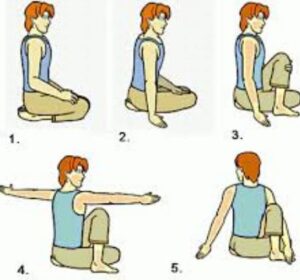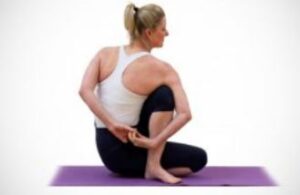“When you listen to yourself, everything comes naturally. It comes from inside, like a kind of will to do something. Try to be sensitive. That is Yoga.”, explained Petri Raisanen.
Thi s yogic posture is named with its founder, Matsyendranath, who was the yoga guru of the 9th century. Ardha-matsyendrasana is a remedial twist that involves strengthening the torso region of the practitioners (Iyengar Yoga, 2021). This Sanskrit word is derived from ‘Ardha’, which means half, ‘matsya’ means fish, Indra means king and asana means the yogic posture. Another name of this yoga is the Half Lord of the Fish Pose, as the yoga involves the twisting of the body, which resembles fish. This seated twist pose is the 12th pose of Hatha yoga.
s yogic posture is named with its founder, Matsyendranath, who was the yoga guru of the 9th century. Ardha-matsyendrasana is a remedial twist that involves strengthening the torso region of the practitioners (Iyengar Yoga, 2021). This Sanskrit word is derived from ‘Ardha’, which means half, ‘matsya’ means fish, Indra means king and asana means the yogic posture. Another name of this yoga is the Half Lord of the Fish Pose, as the yoga involves the twisting of the body, which resembles fish. This seated twist pose is the 12th pose of Hatha yoga.
Perks of practicing this pose!!!
There is a wide range of benefits of practicing Ardha-Matsyendrasana on a regular basis. It helps in stimulating the mind and the body as well. After a whole tiring day with workloads, a few minutes of practicing this yoga will help you in getting rejuvenated and relaxed (Ramamoorthi, Gahreman, Skinner, & Moss, 2021). By alleviating the stress level, it helps in helps in calming down the mind. In this way, this yoga helps in reducing mild depression and stress. By twisting the spinal cord region, it helps in strengthening the back muscles and tones the abdominal region. Regular practicing of this yoga also helps in improving the functioning of the internal organs in the abdominal region (Ramamoorthi, Gahreman, Skinner, & Moss, 2021). Hence, it helps in the betterment of the digestive system and curing constipation. The seated twisting position massages the internal organs of the body thus bringing out the toxins from the body. A toxin-free body with an improved digestive system will give you a better sleep after a tiring day. The regular and efficient practice of this yoga helps to generate self-esteem, willpower, and self-confidence within the practitioners (Iyengar Yoga, 2021). This asana is beneficial in providing a positive outlook. The muscles of the shoulder, hip and neck regions become strengthened with the regular practicing of this yoga and give the thighs a proper stretch that it needs.
Things to be noted before practicing the yoga
Before practicing yoga, the practitioners should keep some important notes in their minds. Otherwise, this could cause some severe injuries. The practitioners should first understand their bodies and their capacity (Ramamoorthi, Gahreman, Skinner, & Moss, 2021). Before twisting they should know their flexibility, and should not create any minds of pressure while twisting their spine. Otherwise, it could harm the spine. At the last stage of yoga, the shoulders should remain in the same pose, where it was the earlier. The yoga instructors suggest that practitioners keep their shoulders in a relaxed state and not too strained. Individuals suffering from any kind of back pain or surgery should avoid doing this pose strictly (Ramamoorthi, Gahreman, Skinner, & Moss, 2021). Pregnant women should also avoid this pose, as it involves the twisting of the abdomen region. Besides, individuals who have gone through any kind of abdominal, brain, and heart surgery should not practice this yoga. Yoga should be practiced only under the proper guidance of a well-trained trainer. The instructors should take proper care of the practitioners, especially those who have a hernia or any kind of ulcer.
References
Iyengar Yoga. (2021, February). Steps towards Ardhya-Matsyendrasana. Retrieved from Iyengar-yoga.co: https://www.iyengar-yoga.co.uk/yoga-blog/health/steps-toward-ardha-matsyandrasana/
Ramamoorthi, R., Gahreman, D., Skinner, T., & Moss, S. (2021). Development of Sham Yoga Poses to Assess the Benefits of Yoga in Future Randomized Controlled Trial Studies. Life, 11(2), 130. Retrieved from https://www.mdpi.com/2075-1729/11/2/130/pdf